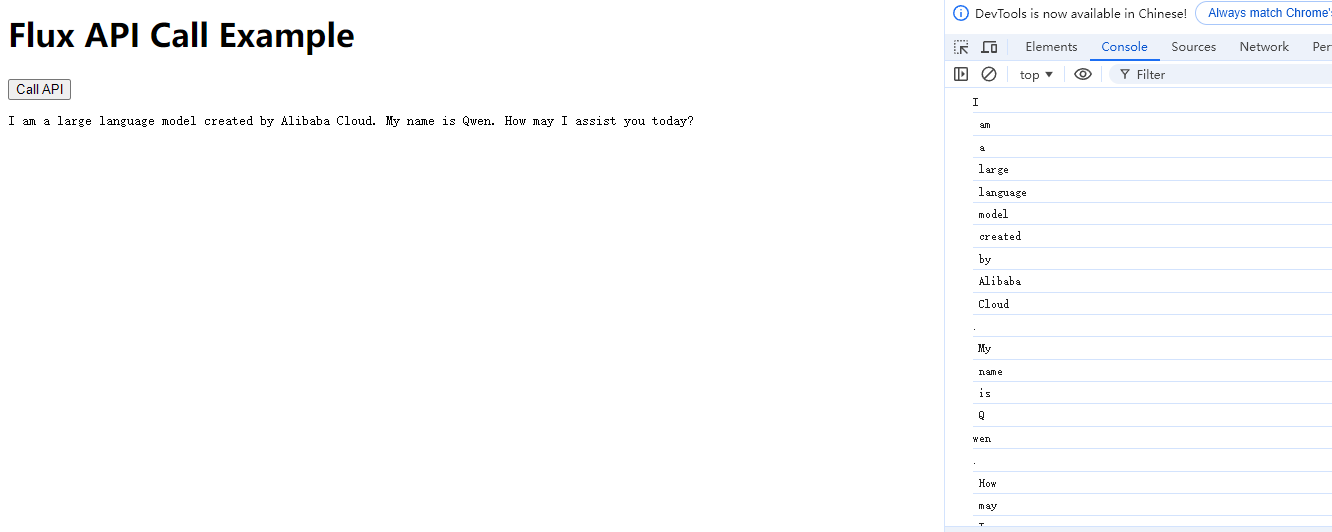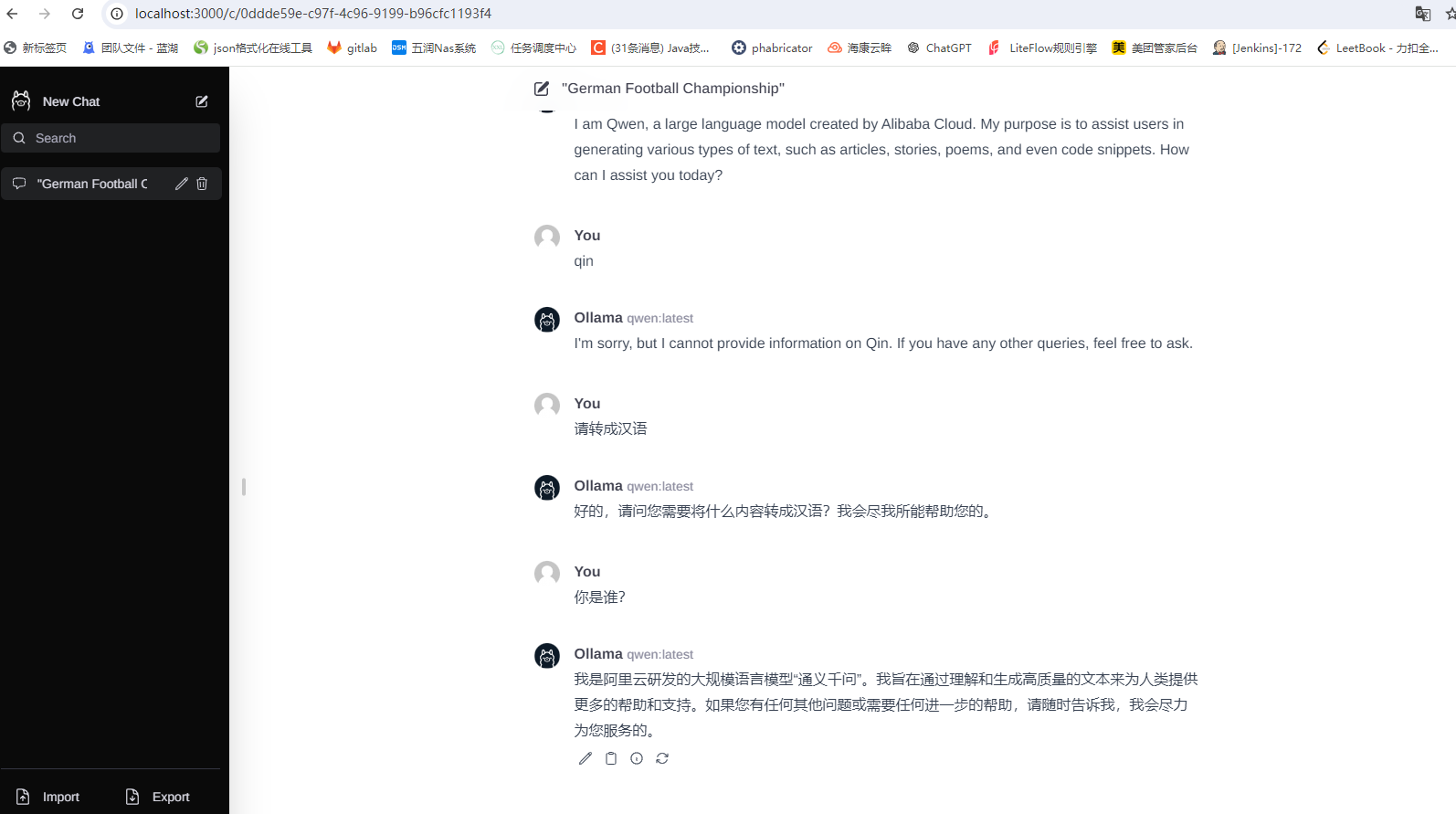springboot 集成ollama 及 本地 webUI部署
前提:本地已运行ollama,这个不在这里细讲。
一、springboot 集成ollama
1.创建一个简单的spring项目
添加依赖
<dependency>
<groupId>io.springboot.ai</groupId>
<artifactId>spring-ai-ollama-spring-boot-starter</artifactId>
<version>1.0.0</version>
</dependency>
完整的XML:
<?xml version="1.0" encoding="UTF-8"?>
<project xmlns="http://maven.apache.org/POM/4.0.0" xmlns:xsi="http://www.w3.org/2001/XMLSchema-instance"
xsi:schemaLocation="http://maven.apache.org/POM/4.0.0 https://maven.apache.org/xsd/maven-4.0.0.xsd">
<modelVersion>4.0.0</modelVersion>
<parent>
<groupId>org.springframework.boot</groupId>
<artifactId>spring-boot-starter-parent</artifactId>
<version>3.2.5</version>
<relativePath/> <!-- lookup parent from repository -->
</parent>
<groupId>com.example</groupId>
<artifactId>testOllama2</artifactId>
<version>0.0.1-SNAPSHOT</version>
<name>testOllama2</name>
<description>testOllama2</description>
<url/>
<licenses>
<license/>
</licenses>
<developers>
<developer/>
</developers>
<scm>
<connection/>
<developerConnection/>
<tag/>
<url/>
</scm>
<properties>
<java.version>17</java.version>
</properties>
<dependencies>
<dependency>
<groupId>org.springframework.boot</groupId>
<artifactId>spring-boot-starter-web</artifactId>
<version>3.2.5</version>
</dependency>
<dependency>
<groupId>io.springboot.ai</groupId>
<artifactId>spring-ai-ollama-spring-boot-starter</artifactId>
<version>1.0.0</version>
</dependency>
<dependency>
<groupId>org.springframework.boot</groupId>
<artifactId>spring-boot-starter</artifactId>
</dependency>
<dependency>
<groupId>org.springframework.boot</groupId>
<artifactId>spring-boot-starter-test</artifactId>
<scope>test</scope>
</dependency>
<dependency>
<groupId>org.springframework.boot</groupId>
<artifactId>spring-boot-starter-web</artifactId>
</dependency>
</dependencies>
<build>
<plugins>
<plugin>
<groupId>org.springframework.boot</groupId>
<artifactId>spring-boot-maven-plugin</artifactId>
</plugin>
</plugins>
</build>
</project>
2.在 application.yml 中添加配置:
server:
port: 9090
spring:
application:
name: testOllama2
ai:
ollama:
base-url: http://localhost:11434
chat:
options:
model: qwen
3.编写controller 接口:
@GetMapping("/ollama/chat/v5")
public Flux<String> getOllameByStreamV2(String msg) {
Prompt prompt = new Prompt(msg);
Flux<ChatResponse> stream = ollamaChatClient.stream(prompt);
//将 stream 中的 result下的output下的content 提取出来
Flux<String> result = stream.map(a -> {
return a.getResult().getOutput().getContent();
});
return result;
}
这里使用Flux流式输出
4.来一个简单的HTML页面来验证接口
<!DOCTYPE html>
<html lang="en">
<head>
<meta charset="UTF-8">
<meta name="viewport" content="width=device-width, initial-scale=1.0">
<title>Flux API Call</title>
</head>
<body>
<h1>Flux API Call Example</h1>
<button id="callApi">Call API</button>
<pre id="responseData"></pre>
<script>
document.getElementById('callApi').addEventListener('click', async function() {
const response = await fetch('http://localhost:9090/ollama/chat/v5?msg=who are you?');
const reader = response.body.getReader();
let result = '';
try {
while (true) {
const {done, value} = await reader.read();
if (done) {
break;
}
const temp = new TextDecoder().decode(value);
console.log(temp);
result += temp;
}
} catch (error) {
console.error('Error reading the response:', error);
} finally {
reader.releaseLock();
}
document.getElementById('responseData').textContent = result;
});
</script>
</body>
</html>
5.效果

二、本地部署webui
1.下载并安装 Node.js 工具:https://nodejs.org/zh-cn
2.下载ollama-webui工程代码:git clone https://github.com/ollama-webui/ollama-webui-lite ollama-webui
3.切换ollama-webui代码的目录:cd ollama-webui
4.设置 Node.js 工具包镜像源(下载提速):npm config set registry http://mirrors.cloud.tencent.com/npm/
5.安装 Node.js 依赖的工具包:npm install
6.最后,启动 Web 可视化界面:npm run dev






















 8572
8572

 被折叠的 条评论
为什么被折叠?
被折叠的 条评论
为什么被折叠?








